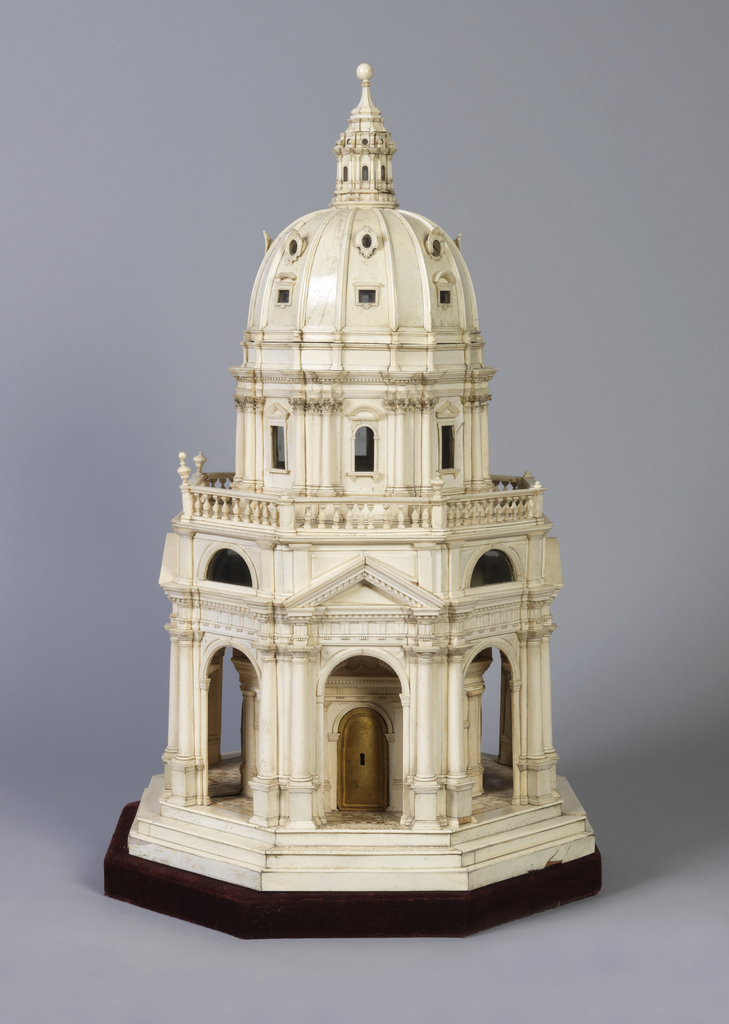When I first saw this model, it immediately struck me as a work of stunning craftsmanship and design that showed the appreciation of a maker of one era for the design of another.
With the elegant proportions featured by architect Andrea Palladio (1508-80), who was also from the Veneto, as well as other late Renaissance designers, the model also suggested the idea of a real building, in marble, with the use of cut and carved ivory giving off the brilliance of white marble in the Italian sun.
The octagon is a very appealing shape architecturally. It allows for flat sides but with a faceted aspect that gives a jewel-like impression. It is also often used for baptisteries, which in the Renaissance were separate buildings from the main church which could feature an impressive baptismal font that held the water when generally a baby was baptized with the sanctified water in it.
Studying the exquisite details more carefully, not only did I notice the alternation of the rounded and triangular pediments over some of the windows on the cupola, but the inscription on the steps at one angle of the building. Embarrassed that my high school Latin was not good enough to get more than a bit of the inscription, I turned to a friend, and former chair of Columbia University’s Classics Department, James R. Zetzel. He provided me with the following rendition of the inscription and a translation that serves to give us back a wonderful part of this model’s early history.
Baptistery Inscription
A. P. R. M.
HOC.OPUS. A. DNO. JHO.
BAPTA.RASIO.CAPITIS.AGGE
RIS.SACERD. IMPROBO.TRIENII
EXACTVM.LABORE.PIO.VI.PONT.
MAX. E.GERMANIA.REDUCI.DUM.ANGULARIAE.PER.CIMBAM.TRANS
ATHESIM.VEHERETUR.FUIT.OBLATUM.TANTAQ.SS.PATRIS ANIMUM
ADMIRE.PERCULIT. UT.IPSUM.TER.BENEDICENS.AUCTOREM.SUUM.QUOQ.SPI
RITUALIBUS.CUMULARIT.DONIS.XIII.KAL.JUL.A.P.C.N.M.D.CC.LXXXII.
A.P.R.M
Hoc opus a domino (Giovanni Baptista Rasio?) Capitis Aggeris Sacerdos improbo trienii exactum labore Pio VI Pontifici Maximo e Germania reduci dum Angulariae per cimbam trans Athesim veheretur fuit oblatum tantaque sanctissimi patris animum admiratione perculit ut ipsum ter benedicens auctorem suum quoque spiritualibus cumularit donis. xiii Kal. Jul. anno post christum natum MDCCLXXII.
Translation:
This work, completed in three years’ hard work by Giovanni Baptista Rasio (Name?), the priest of Caput Aggeris (Cavarzere, in Veneto), was presented to Pius VI, Pontifex Maximus, on his return from Germany while he was crossing the river Athesis (Adige) by boat at Angularia (Anguiluara Veneta), and it affected the mind of the Holy Father with such admiration that he thrice blessed its maker and heaped him with spiritual gifts. June 19, A.D. 1782.
The inscription suggests that the priest, whose name, if it was Giovanni Baptista (John the Baptist) Rasio, is apt for someone making a baptistery model, kept the model after it was blessed by the priest and inscribed it to enable those who saw it later to know of its significance. The facts of the opportunity to present this to Pope Pius VI can be corroborated by contemporary accounts, as it is known that the pope travelled to Vienna (the German speaking lands of the inscription), in 1782 as Joseph II of Austria had been suppressing monasteries, so Pius resolved to go to Vienna. He left Rome on 27 Feb, 1782 and arrived in Vienna on 22 March, where he stayed a month leaving on 22 April, and was received by Cardinal Bufalini in Ancona, in June 1782. He would have traversed the Veneto slightly before reaching Ancona, so the June 19th date seems very plausible.
The inscription on this model shows the importance of models as presentation and collection objects. It also demonstrates the importance of both Palladio and of the neo-classical elements of Renaissance design on the late eighteenth century when this model was made and when neo-classicism was again at its height, as well as its appeal through many centuries via publication of prints of Palladio’s architecture in particular. That the model’s creator was full of admiration for the full-size building and Pope Pius’s admiration for the model is clear from the fact that the priest-creator from Cavarzere in the Veneto took three years to make it, and deemed it worthy of presentation to Pope Pius VI in 1782. That the pope so blessed him was a great honor. The inscription in Latin reflects the model’s and maker’s ecclesiastical connections as Latin was the language of the Roman Catholic Church until well into the twentieth century. It also is a reminder of the connections with the architecture of antiquity being adapted later for ecclesiastical use.
There are still a few mysteries. We do not yet know anything about its creator, other than the fact that he was a priest in the 1780’s in Cavarzere a town in the Veneto. We also do not know where the building was or is on which this model is based. Searches of photographs of Cavarzere, Venice and other towns in the Veneto have not yet revealed this, and it could have been built in Rome or elsewhere, if either the priest had travelled or used an engraved source. The vitality of this model leads me to think that the priest had first-hand exposure and love for the building he was emulating as a model. Does anyone know where it is? Please let us know.
This architectural model will be on view beginning December 12th in the Models & Prototypes Gallery, part of Cooper Hewitt’s opening exhibitions. It is a gift of the Thaws.
Sarah D. Coffin is the Head of the Product Design and Decorative Arts Department at Cooper Hewitt, Smithsonian Design Museum. She curated the exhibition Made to Scale: Staircase Masterpieces The Eugene and Clare Thaw Gift.
